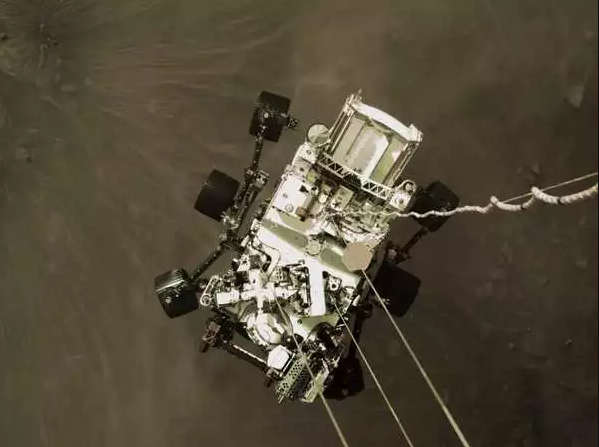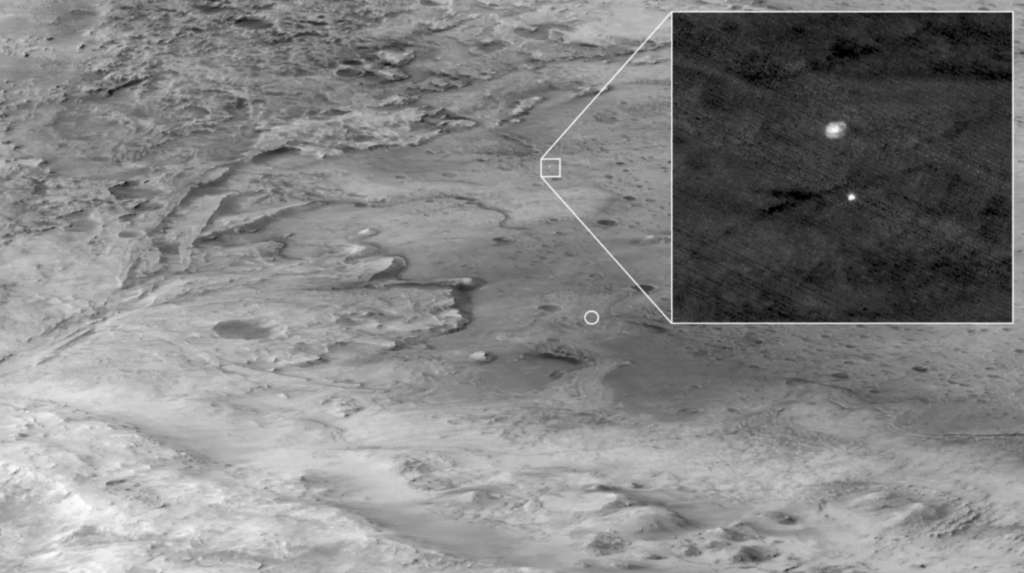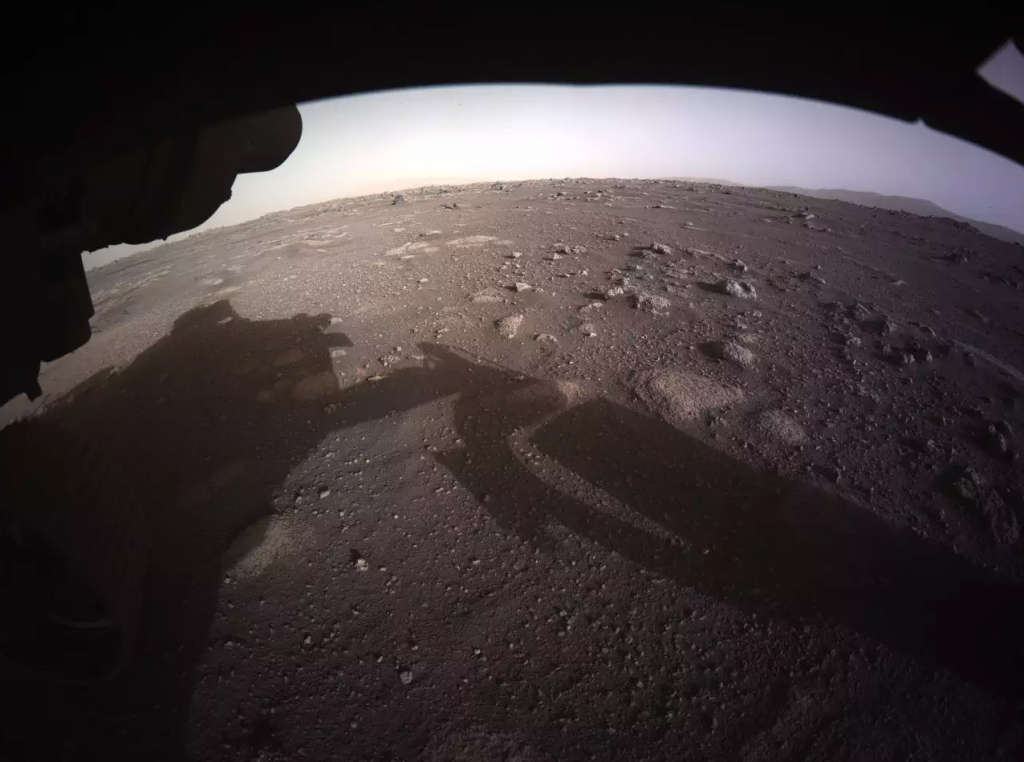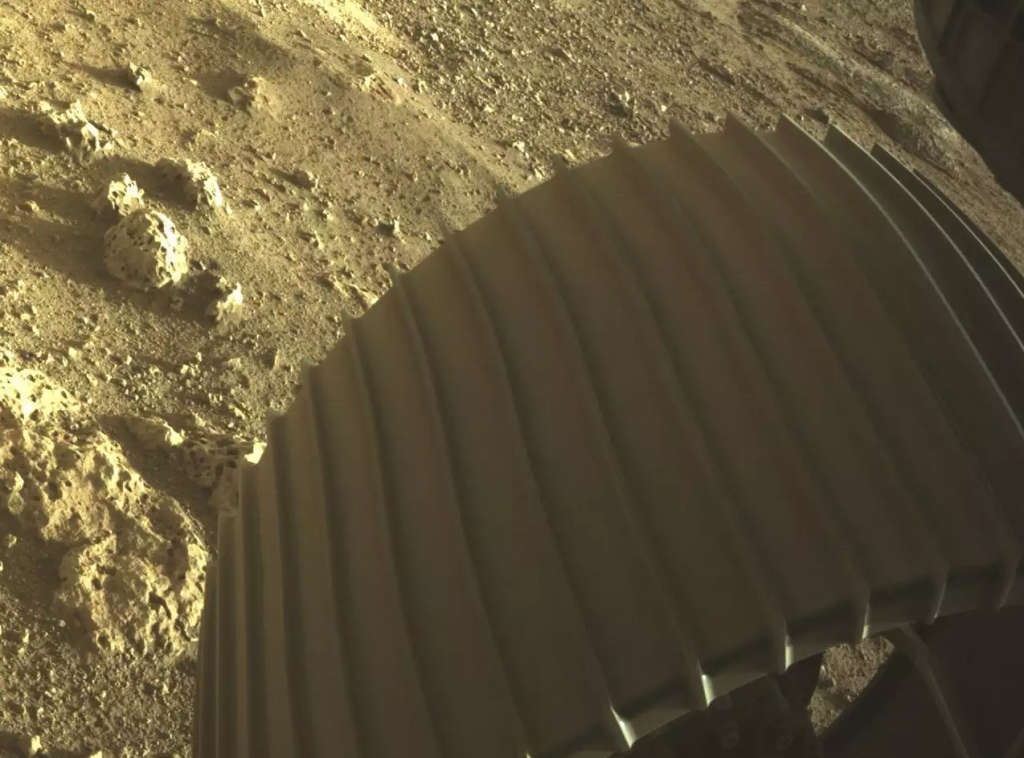NASA’s Perseverance rover had returned to earth the first-ever photo of a Mars touchdown

NASA has published the first image ever taken during a Mars touchdown.
The picture, above, reveals the Perseverance rover hanging below the jetpack that lowered it to the planet’s surface on Thursday.
A camera on the bottom of the jetpack captured the shot – it’s one of six cameras installed into the rover and its landing apparatus in order to record the entire descent and landing. The cameras’ surveillance footage of the landing could be available as early as Monday since the rover is still beaming back its results.
As an early peak, NASA released a series of images from the descent and the landing site on Friday.
“This is something that we’ve never seen before. It was stunning, and the team was awestruck, and you know there was just a feeling of victory that we were able to capture these and share it with the world,” said Aaron Stehura, deputy leader for the rover’s entry, descent, and landing phase, stated in a briefing on Friday.
In the picture above, according to mission managers, the rover is possibly about six feet (two meters) above the Martian surface. The jetpack’s engines are stirring up plumes of dust.
Katie Stack Morgan, the mission’s deputy project scientist, stated in the briefing. “I did a double-take and said ‘that’s the actual rover!’ Just to think that the last time I saw the rover like this, it was in the high bay [at the Jet Propulsion Laboratory] is just incredible,”
Now that Perseverance has survived its trip and stuck the landing, the rover is poised to spend the next two years scouring the river delta of Jezero Crater for signs of ancient alien existence The river that once flowed into the crater may have dumped mud and clay where it met the lake, and that would have trapped microbial life – if it ever existed. Perseverance carries 43 vials for chucking samples of Martian rock and soil, including anything that looks like alien fossils. NASA is preparing to send another mission in the 2030s to carry those samples back to The earth.
First views of a landing on Mars, up close and from space
The spacecraft that took Perseverance to Mars released a capsule containing the SUV-sized rover on Thursday afternoon. The capsule, pulled by the gravity of the earth, plummeted at more than 12,000 mph through the Martian atmosphere, firing its thrusters to remain on track. The atmospheric material around the capsule was super-heated by friction from this high speed to about 2,370 degrees Fahrenheit, but the rover inside was covered by a heat shield.
Then a 70-foot-wide parachute was deployed by the capsule, slowing its fall to around 150 mph – twice the speed of a dropping skydiver with no parachute.
Up in space, with the parachute dropping toward Mars, the Mars Reconnaissance Orbiter found the capsule. It is unclear whether this photo was taken before or after the rover was lowered by the capsule, though.

The capsule’s heat shield dropped away after the parachute was deployed, revealing the underside of the rover so that its cameras could assess the ground below. Boulder fields, sand dunes, and 200-foot cliffs that could have spelled doom for Perseverance were detected by an onboard navigation device.
A jetpack attached to the back of the robot fired its engines once the capsule lowered the rover and steered Perseverance to a clear, flat landing spot.
Hovering above the earth, before the rover’s wheels met the ground, the jetpack lowered Perseverance on 25-foot nylon cords. That’s when the shot of the rover above the Martian surface was taken by his camera.
The first color pictures of the rover show rocks with holes.
Perseverance will spend the next few weeks testing its systems, then launch the first interplanetary helicopter ride – the aircraft is stored in the belly of the rover. In the summer, mission managers expect the rover to begin gathering rock samples.
But the first color images from the science cameras of Perseverance already have scientists buzzing.
“As soon as we got that color image from the surface of Mars, our chats just lit up with the science team saying ‘look over here and look over here,'” Stack Morgan stated.

Mission executives assume that the 200-foot cliffs of the ancient river delta are peeking out on the horizon in the photo above.

“Depending on what the origin of these rocks is, these holes could mean different things. So we’re excited to follow up on that and find out really what’s going on here,” Stack Morgan stated.

